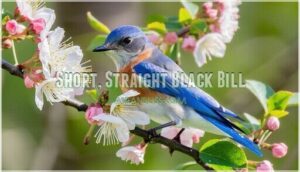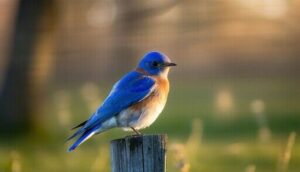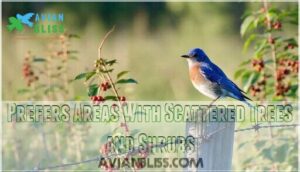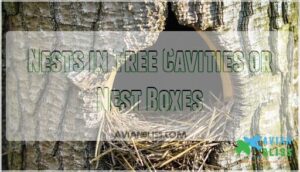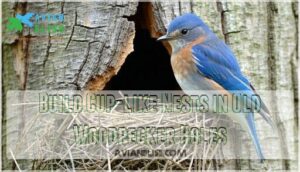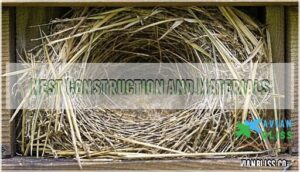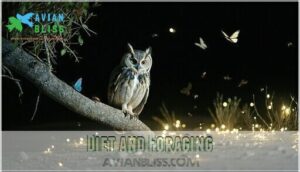This site is supported by our readers. We may earn a commission, at no cost to you, if you purchase through links.

They’re medium-sized songbirds that measure about 6-8 inches long and prefer open woodlands, fields, and meadows across eastern North America.
They’re cavity nesters, building homes in old woodpecker holes or nest boxes you might provide.
Eastern bluebirds feast on insects like beetles and crickets during warmer months, switching to berries when it’s cold.
Once nearly extinct due to habitat loss, their populations have bounced back thanks to conservation efforts. What saved these beloved birds reveals fascinating strategies you can use in your own backyard.
Table Of Contents
- Key Takeaways
- Eastern Bluebird Overview
- Physical Characteristics
- Habitat and Nesting
- Diet and Foraging
- Conservation and Attraction
- Frequently Asked Questions (FAQs)
- What does it mean when you see an eastern bluebird?
- Are Eastern Bluebirds rare to see?
- Do Eastern Bluebirds live in birdhouses?
- What does it mean when a Eastern bluebird visits you?
- What attracts Eastern Bluebirds to your yard?
- What trees do Eastern Bluebirds nest in?
- What is the lifespan of an Eastern Bluebird?
- Do Eastern Bluebirds migrate in winter?
- How do Eastern Bluebirds court mates?
- What sounds do Eastern Bluebirds make?
- Conclusion
Key Takeaways
- You’ll recognize eastern bluebirds by their brilliant blue heads and wings paired with rust-orange throats, measuring 6-8 inches long in open woodlands and meadows across eastern North America.
- You can attract them to your yard by installing nest boxes 5-6 feet high in open areas, offering mealworms at feeders, and planting native berry plants like dogwood and elderberry.
- They’re cavity nesters that build cup-shaped homes in old woodpecker holes or nest boxes you provide, feeding mainly on beetles and crickets in summer and switching to berries in winter.
- You’re witnessing a conservation success story – their populations recovered from near-extinction in the 1970s to 23 million birds today through dedicated nest box programs and habitat restoration efforts.
Eastern Bluebird Overview
You’ll recognize the Eastern Bluebird by its brilliant blue plumage and rusty-orange breast as it perches on fence posts across open meadows and fields throughout eastern North America.
A flash of royal blue against emerald meadows signals nature’s most cherished songbird soaring home.
This small thrush, scientifically known as Sialia sialis, serves as the state bird for both New York and Missouri and remains one of the most beloved songbirds in North America.
Bright Blue Bird Native to Eastern North America
Across eastern North America, you’ll spot the eastern bluebird’s brilliant royal blue plumage gleaming in open meadows and farmlands.
Males showcase vibrant blue heads, backs, and wings with rust-colored chests, while females display subtler grayish-blue tones.
Their bluebird song echoes through preferred habitats of scattered trees and grasslands, where juvenile development occurs in cavity nests, showcasing a unique aspect of their juvenile development.
State Bird of New York and Missouri
When you look at State Symbolism, the eastern bluebird stands tall as the state bird for both New York and Missouri.
Here’s why it matters:
- Bird Adoption began in Missouri (1927), then New York (1970).
- State Recognition highlights NY Bluebird and MO Bluebird pride.
- Known as the Blue Bird of Happiness.
- Represents North American birds.
- Symbolizes cheerful bird symbolism.
New York made its selection of official state bird on May 18, 1970.
Found in Open Woodlands, Fields, and Meadows
Eastern bluebirds thrive in open country where scattered trees meet grasslands, creating the perfect balance of perching spots and hunting grounds.
You’ll spot these vibrant birds in meadows, golf courses, and farmland edges where habitat fragmentation creates diverse microenvironments that support abundant insect populations and varied food availability throughout their roaming range.
| Habitat Feature | Benefit for Bluebirds |
|---|---|
| Open meadows | Rich insect hunting grounds with clear sightlines |
| Scattered trees | Essential perching posts for spotting prey |
| Field edges | Reduced predator density compared to dense forests |
| Mixed vegetation | Minimizes negative edge effects while maximizing foraging opportunities |
Scientific Name and Classification
Scientists classify you’ll find the eastern bluebird under its scientific name Sialia sialis within the taxonomic hierarchy. This small songbird belongs to the order Passeriformes and sits within the thrush family Turdidae, sharing evolutionary relationships with robins and other ground-foraging birds.
Here’s how taxonomic history places this species:
- Order Passeriformes encompasses over half of all bird species worldwide
- Family Turdidae includes thrushes, robins, and bluebirds with similar feeding habits
- Genus Sialia contains three North American bluebird species with distinct ranges
- Subspecies variation exists across different geographic regions within the eastern range
- Evolutionary relationships link bluebirds to other cavity-nesting songbirds through shared ancestors
The classification highlights the eastern bluebird’s position within a broader biological context, emphasizing its connections to other species and its place in the natural world.
Spanish and French Names
Learning the Eastern Bluebird’s international names opens doors to cross-cultural birdwatching connections.
You’ll encounter Azulejo Oriental in Spanish-speaking regions and Merlebleu de l’Est in French territories.
These name origins reflect each language’s unique approach to describing this beloved species.
| Language | Name | Pronunciation |
|---|---|---|
| English | Eastern Bluebird | EES-tern BLOO-bird |
| Spanish | Azulejo Oriental | ah-soo-LEH-ho or-ee-en-TAHL |
| French | Merlebleu de l’Est | mer-luh-BLEU duh LEST |
Physical Characteristics
You’ll immediately recognize an Eastern Bluebird by its compact build featuring a rounded belly, long wings, and short legs paired with a small, straight black bill.
Male bluebirds display brilliant blue coloring on their heads and wings, complemented by a rust-orange throat and chest that gradates to a white belly.
While measuring 6.5-8 inches long and weighing about one ounce, they exhibit distinct physical characteristics.
Round Belly, Long Wings, Short Legs
You’ll notice the eastern bluebird’s compact build features distinctive body proportions that make bluebird identification straightforward.
Their flight mechanics depend on these physical features, while their perching ability stems from specialized leg function.
- Round belly: Creates the bird’s characteristic stocky silhouette
- Long, pointed wings: Enable efficient gliding and quick directional changes
- Short, sturdy legs: Provide excellent grip strength for wire perching
- Compact frame: Measures 5.5-7 inches with streamlined bird posture
- Juvenile appearance: Shows similar proportions with grayer bird colors
Short, Straight Black Bill
You’ll notice the eastern bluebird’s small, straight black bill perfectly complements its compact body design.
This specialized bill morphology serves multiple feeding adaptations, allowing precise insect capture and berry consumption. Beak function varies seasonally—sharp enough for cricket hunting, yet gentle for fruit picking.
| Feature | Male | Female |
|---|---|---|
| Bill Color | Jet black | Dark gray-black |
| Bill Length | 0.4-0.5 inches | 0.4-0.5 inches |
| Bill Shape | Straight, pointed | Straight, pointed |
Bill development occurs during juvenile stages, with bill variations minimal between sexes for ideal bluebird identification.
Bright Blue Head and Wings (males)
Male Eastern Bluebirds showcase brilliant blue plumage that catches sunlight like scattered sapphires.
You’ll notice their royal blue head and wings display varying blue intensity depending on lighting conditions.
Male plumage genetics create this stunning coloration through specialized feather structures.
Their wing shape enhances flight agility while their skyblue feathers shift from deep cobalt to lighter azure during display behavior.
Rust-colored Throat, White Stomach
The male Eastern Bluebird’s breast displays warm reddish-brown plumage that creates striking Sexual Dimorphism against the brilliant blue above.
This redbrown coloration extends from the throat down to the upper chest, gradually fading to white on the belly.
Color Intensity varies among male birds, with some showing deeper rust tones than others.
Female birds exhibit much subtler orange-brown breast markings, demonstrating clear Plumage Variation between sexes in this beloved eastern bluebird species.
Length and Weight
Eastern bluebirds display consistent size measurements across their range, with adults reaching 5.5 to 7 inches in length.
You’ll notice these compact songbirds weigh between 0.95 and 1.20 ounces, showing minimal sexual dimorphism in size.
Their wingspan stretches 9 to 12 inches, perfectly proportioned for their agile hunting style and efficient flight patterns through open meadows.
Habitat and Nesting
Eastern bluebirds thrive in open areas where scattered trees and shrubs create the perfect balance of hunting grounds and nesting spots.
You’ll find these cavity nesters making their homes in old woodpecker holes, natural tree hollows, or the nest boxes that caring bird enthusiasts provide throughout their range.
Prefers Areas With Scattered Trees and Shrubs
You’ll find eastern bluebirds thriving in open habitat needs where scattered trees dot expansive grasslands and meadows.
These bird species prefer areas with roughly 25-50% shrub density impact, avoiding heavily wooded regions.
Edge habitat value becomes critical as bluebirds need clear sightlines for hunting insects while maintaining nearby perches.
Their roaming range size typically spans several acres of mixed terrain.
During winter habitat selection, bluebird habitat shifts toward areas with persistent berry sources and southern-facing slopes that offer protection from harsh winds, utilizing open habitat and mixed terrain.
Nests in Tree Cavities or Nest Boxes
You’ll find eastern bluebirds choosing tree cavities or nest boxes for their homes.
They prefer entrance holes around 1.5 inches wide, perfect cavity size preferences for multiple broods yearly.
Smart nesting material selection includes grass, pine needles, and feathers for cozy interiors.
Proper nest box placement at 4-6 feet high helps avoid competition from aggressive species, and these cavity nesting birds readily accept birdhouses when natural options are scarce, with Various bluebird houses available for purchase.
Build Cup-like Nests in Old Woodpecker Holes
You’ll find eastern bluebird pairs transforming abandoned woodpecker holes into cozy homes through careful cavity nesting.
The female constructs her cup-shaped bluebird nest using specific materials and dimensions that facilitate successful breeding.
Here’s how eastern bluebirds build their woodpecker hole nests:
- Nest Materials – Females weave grasses, pine needles, and feathers into a soft cup
- Nest Dimensions – Interior measures 2-3 inches deep with 3-inch diameter opening
- Nest Sanitation – Parents remove waste to maintain clean nesting environment
- Competition Avoidance – Select holes too small for starlings but perfect for bluebird nesting habits
Nest Site Selection and Height
You’ll find eastern bluebird nest sites positioned strategically between three and fifty feet above ground, with most cavity size preference favoring entrances around 1.5 inches.
This height predator risk balance protects against ground threats while remaining accessible.
Bluebirds select nest boxes and natural cavities for competition avoidance, often choosing urban nesting sites near open areas with scattered perches for ideal hunting access.
Nest Construction and Materials
Once you’ve chosen your birdhouse location, the female eastern bluebird starts nest construction using dry grasses, pine needles, and straw.
She completes the cup-shaped structure within four to five days, lining it with fine materials like animal hair or feathers.
Egg incubation typically lasts 12-14 days.
Cavity size preference affects construction timing, while proper nest material types guarantee the best brood success rates in your nest box design, promoting superior results with the right nest box design and nest material types.
Diet and Foraging
Eastern bluebirds eat insects like beetles, crickets, and caterpillars during spring and summer, making up about 68% of their diet.
They switch to berries and fruits in fall and winter when insects become scarce.
Over 50% Beetles, Crickets, Grasshoppers, Caterpillars
Insects make up roughly 68% of the bluebird diet throughout the year.
You’ll find these birds hunting beetles, crickets, grasshoppers, and caterpillars with remarkable precision.
Their beetle predation skills shine as they target ground-dwelling species, while grasshopper abundance during summer provides excellent protein sources.
Cricket hunting techniques involve patient perching followed by swift ground swoops.
Caterpillar consumption peaks during breeding season when insect nutritional value becomes critical for growing chicks.
Fruits and Berries During Colder Months
When the mercury drops, eastern bluebirds swap their insect-heavy menu for nature’s candy.
Winter fruit availability becomes their lifeline, with these savvy birds adapting their foraging behavior to seek out:
- Dogwood berries – packed with fat for energy storage
- Sumac clusters – providing essential vitamins during harsh months
- Wild grapes – offering vital carbohydrates for survival
This dietary shift showcases remarkable cold-climate berry adaptations, ensuring these beloved birds weather winter’s challenges.
Skilled Fliers With Excellent Vision
Eastern bluebird aerial hunting showcases remarkable precision through their exceptional vision acuity.
You’ll observe these insectivorous birds employing sophisticated flight patterns, combining perch hunting with impressive hovering skills.
Their side-positioned eyes provide panoramic surveillance, enabling swift detection of ground movement from elevated positions.
| Flight Technique | Vision Advantage |
|---|---|
| Perch Hunting | 180-degree field of view |
| Aerial Hawking | Motion detection accuracy |
| Ground Swooping | Depth perception clarity |
| Hovering Skills | Target acquisition speed |
Bird foraging becomes effortless when you possess such visual mastery, making eastern bluebird hunting strategies highly effective and showcasing their ability to utilize aerial hawking with great precision, thanks to their exceptional vision.
Use of Vocalizations for Communication and Predator Warnings
Bluebird-song complexity showcases remarkable vocal diversity, with males producing up to 81 distinct song types for territorial defense and mate attraction.
You’ll hear soft warbling "tu-a-wee" notes during courtship, while sharp "chur" alarm calls warn of predators like raccoons or cats.
These contextual vocalizations help eastern bluebirds coordinate parental care and maintain social bonds throughout their breeding territories, which is crucial for their survival and showcases their vocal diversity.
Foraging Strategies and Techniques
You’ll typically observe Eastern Bluebirds employing three distinct foraging strategies throughout the year.
These birds excel at aerial hawking, ground foraging, and seasonal diet adaptation based on food availability.
- Sit-and-wait strategy: They perch on low branches, scanning for insects before swooping down to catch prey
- Aerial hawking: They flutter-chase flying insects mid-air with impressive precision and timing
- Seasonal switching: Their insect consumption peaks in summer while berry preference increases during colder months
Their foraging success depends on excellent vision and strategic positioning near open areas where spiders, earthworms, and various insects remain accessible.
These open areas are essential for ground feeding behaviors, allowing them to forage safely.
Conservation and Attraction
You can help Eastern Bluebirds thrive by creating the right environment in your yard and supporting conservation efforts.
Simple actions like installing proper nest boxes and avoiding harmful pesticides make a real difference for these beautiful birds that once faced serious population declines.
Provide Nest Boxes and Native Plants
You’ll create a haven for eastern bluebirds by positioning nest boxes 5-6 feet high in open areas with proper drainage.
Space birdhouses 100 yards apart to prevent territorial disputes. Consider exploring options to find suitable bluebird houses for your backyard.
Plant native berries like dogwood, elderberry, and sumac to provide winter food sources. Design your garden with scattered trees and shrubs, creating the perfect blend of open foraging space and natural shelter that attracts bluebirds year-round.
Offer Mealworms at Feeders and Avoid Pesticides
You can supercharge eastern bluebird visits by offering protein-rich mealworms at strategically placed bird feeders.
These nutritious treats provide essential energy, especially during breeding season when adults need extra fuel for feeding nestlings.
Here’s your mealworm feeder setup:
- Feeder Placement: Position feeders 5-6 feet high in open areas with clear sight lines
- Mealworm Benefits: Offer live or dried mealworms in shallow dishes during morning hours
- Pesticide Alternatives: Switch to organic gardening methods to protect bluebird safety from harmful chemicals
Avoiding pesticides creates a healthier environment where bluebirds can hunt naturally without encountering toxic insects.
You can find various mealworm feeder options online.
Population Decline and Recovery Efforts
By the 1970s, eastern bluebird populations had plummeted 90% due to habitat loss, invasive competition from starlings, and pesticide impact.
By the 1970s, these beloved songbirds nearly vanished from our skies forever.
Conservation efforts launched widespread nest box programs and monitoring initiatives, which proved to be effective strategies for population recovery.
Volunteers created bluebird trails, tracking reproduction success, and these efforts, combined with dedicated habitat restoration, contributed to the recovery of the species.
These population recovery strategies proved remarkably effective, with numbers rebounding from near-extinction to approximately 23 million birds today, a testament to the power of conservation efforts.
Threats and Conservation Status
Despite conservation successes, eastern bluebirds still face significant threats today.
Habitat loss from development continues reducing nesting sites, while pesticides diminish insect prey populations.
Invasive species like European starlings create intense nesting competition, and climate change may shift their range northward, reducing southern habitat.
Though currently rated "Low Conservation Concern" with 23 million individuals, ongoing conservation efforts remain necessary for population stability.
Habitat fragmentation further isolates populations, making continued conservation crucial for the population stability.
Ways to Support Eastern Bluebird Conservation
You can make a real difference for eastern bluebird conservation through simple actions.
Install bluebird boxes with proper nest box placement in open areas near trees. Plant native species that produce berries bluebirds love.
Reduce pesticide use in your yard to protect their insect food sources.
Monitor bluebird trails in your community and support conservation groups working to protect these beautiful birds through habitat restoration efforts.
Frequently Asked Questions (FAQs)
What does it mean when you see an eastern bluebird?
Blue against gray skies signals hope’s arrival. You’re witnessing nature’s promise that brighter days follow darkness. Eastern bluebirds represent renewal, joy, and good fortune appearing when you need encouragement most.
Are Eastern Bluebirds rare to see?
You’ll spot these birds fairly easily across much of eastern North America. They’re common in open areas like meadows, golf courses, and farmland, especially where nest boxes exist.
Do Eastern Bluebirds live in birdhouses?
You’ll find these cavity-nesting champions practically living in your backyard birdhouses. Eastern Bluebirds readily adopt artificial nest boxes, often preferring them over natural tree hollows, making birdhouses their cozy homes.
What does it mean when a Eastern bluebird visits you?
When an Eastern Bluebird visits you, it typically means you’ve created suitable habitat with open areas, perches, and food sources nearby.
They’re attracted to properties offering insects, berries, and potential nesting sites.
What attracts Eastern Bluebirds to your yard?
Like gems scattered across nature’s canvas, these azure beauties seek open meadows with scattered perches.
Native berry plants, mealworm feeders, and nest boxes positioned five feet high in sunny locations away from dense trees.
What trees do Eastern Bluebirds nest in?
Cavity nesters prefer natural tree hollows and old woodpecker holes in large trees, typically positioning nests 3-50 feet above ground in open areas near rich foraging grounds.
What is the lifespan of an Eastern Bluebird?
You’ll find these colorful songbirds typically live 6-10 years in the wild, though some lucky individuals can reach up to 10 years with favorable conditions and minimal predation pressure.
Do Eastern Bluebirds migrate in winter?
Picture flocks of azure wings against winter’s pale sky. You’ll find these birds are partially migratory, moving south when harsh conditions make northern territories unsuitable for survival.
How do Eastern Bluebirds court mates?
You’ll witness male Eastern Bluebirds performing elaborate displays during courtship season.
They flutter their wings dramatically, puff up their brilliant blue plumage, and sing sweetly while presenting food gifts to potential mates as romantic offerings.
What sounds do Eastern Bluebirds make?
You’ll hear Eastern Bluebirds produce soft, warbling calls that sound like "chur-lee, chur-lee" along with short chattering notes, gentle trills, and melodic whistles during breeding season conversations.
Conclusion
Sure, these conservation efforts have transformed the eastern bluebird from near-extinction to thriving populations across their range.
You can support these remarkable birds by installing proper nest boxes, planting native berry-producing plants, and avoiding pesticides in your yard.
Their recovery proves that dedicated conservation work actually works, and when you provide suitable habitat, eastern bluebird families will reward you with their stunning colors and melodic songs throughout the breeding season.
- https://www.allaboutbirds.org/guide/Eastern_Bluebird/lifehistory
- https://avianreport.com/eastern-bluebird-habitat/
- https://www.reddit.com/r/birding/comments/1gs1vir/eastern_bluebird_at_feeder_for_the_first_time_any/
- https://nestboxlive.com/blog/nesting-behaviors-of-eastern-bluebirds-in-the-usa/
- https://www.fairfaxcounty.gov/soil-water-conservation/eastern-bluebirds-story-successful-conservation


